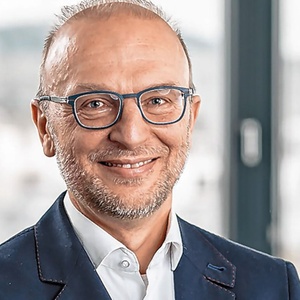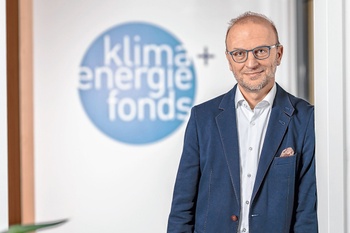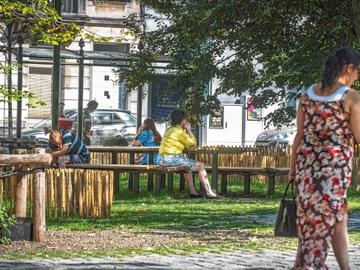Organising the cooling of public spaces is necessary, but it will not be enough. So says Bernd Vogl, director of the Austrian Climate and Energy Fund. We also need to tackle buildings so that they can cool down in a climate-friendly way. "And that means more than solar shading," he says.
© KlimaFonds
| Bernd Vogl van het Oostenrijkse klimaat- en energiefonds.
Who is Bernd Vogl?
- 56 years
- Studies business administration with focus on environmental economics
- Energy expert and leading official in the Austrian federal environmental administration (2004-2011)
- Head of the energy planning department of the city of Vienna (2011-2022)
- Director at Wien Energie (2016-2022)
- Chairman of the Austrian Climate and Energy Fund (since 2023)
Sweltering! We feel like a walking fountain again as we enter the offices of the Climate and Energy Fund. The headquarters are a stone's throw from the fast-flowing and cool Danube Canal. Yet the place is coloured dark orange and therefore hot on the Vienna heat map. This immediately shows how extraordinarily local the influence of cooling factors can be. From the meeting room where Bernd Vogl is talking to us, we look out over the Karl-Marx-Siedlung, the city's best-known and largest social housing complex, stretching for more than a kilometre. Vogl is particularly concerned about the most vulnerable residents of this type of housing. "I can get a bit angry when I hear that we are not going to build cooling into new social housing," he says.
This week we reached 36 degrees in Vienna. How did you experience the heat yourself?
Bernd Vogl: I live a bit further outside the city, where it is still bearable, although it is also quite hot in the Wienerwald. Here at the office, it is fortunately pleasant.
We have seen in Vienna that a lot is already being done to cool public spaces. Those efforts will not prevent it from becoming increasingly too hot outside. Shouldn't we do more to make our buildings as cool as your office?
Vogl: Yes indeed. In our latitudes, it has long been assumed that we should only use solar shading. However, the past few years have shown that you can use heat pumps to cool without the disadvantages of traditional air conditioning, which blows hot air outside and is bad for the climate. Heat pumps even need this in densely built-up areas, because their probes would otherwise freeze (geothermal heat pumps draw heat from the ground in winter and cool it in summer. The pump's earth probes therefore cool down in winter and warm up when they cool down, ed.). What really fascinates me: the cooling requirement of such a pump is quite a bit larger than what you need to cool houses in summer, which means we can start to think of applications where heat pumps cool public spaces.
Are there already examples of heat pumps cooling public spaces?
Vogl: In Vienna, a project is already underway to cool a small street. I would like us to try this with a playground or part of a park. You can also blow cold air into the city via those heat pump systems. This is not as efficient as cooling a precisely defined area such as a playground, but it is something.
"We need industrialization, both to combat global warming and to adapt to it"

I find the principle so fascinating because you protect the climate at the same time (if the heat pump runs on geothermal and green energy, there are basically no CO2 emissions from fossil fuels, ed.) and you also adapt to the consequences of global warming. Of course, some people say that it is expensive, that the heat networks we have in Vienna (centrally generated heat, about half based on natural gas, ed.) are much cheaper. I get a bit miffed by that. So are we really not going to build this kind of technology into new social housing, into the homes of those most vulnerable to the effects of heatwaves?
Is this insight also gaining ground in Vienna?
Vogl: Yes, the social housing companies are on board. And things are also happening when it comes to existing buildings. Vienna has really taken the lead in moving away from gas and towards sustainable solutions for heating and cooling. I am convinced that many cities will want to see what we are doing here in the next few years.
We actually wanted to ask what Vienna is particularly good at when it comes to climate adaptation, but you already gave us the answer.
Vogl: Vienna also built a water supply from the mountains 150 years ago, dimensioned for three million inhabitants, half as many as today! As a result, we can easily afford all those water sprays (Vienna has over three hundred water sprays in various forms, which start automatically in periods of high temperatures, ed.).
And what could be better?
Vogl: It has taken us a long time to succeed in creating genuine new green spaces in new parts of the city. For a long time, the fire brigade was the strongest force. The city planners made a plan with lots of trees and after the fire brigade spoke, it was: "Bäume weg!" ... While trees are essential for cooling. The effect of green roofs, especially if it is only a thin layer of soil, is much smaller. What is also not going smoothly here is using our streets differently and making them greener.
You mean by reducing car traffic?
Vogl: Yes. We are not as bold as in Paris or other cities. The social democrats are divided on that issue. You have the greener leftists. And then there is the old guard, which is not much different from the conservatives (laughs). And that old male guard is usually in charge.
That being said, the current city government does its best. But creating more space for bicycles and greenery in an existing city structure is a tough process. What does help: Vienna has introduced a public transport pass costing 365 euros, one euro a day. That has led to a big increase in the number of users, making it slightly easier to keep the number of cars under control. That, in turn, is an advantage if you want to reallocate public space to get more green space, for example.

© KlimaFonds
| Bernd Vogl: "I am convinced that a lot of cities in the next few years will want to see what we are doing here in Vienna."
That sounds very familiar. Something else: for many of the people we have spoken to, the challenge is to take existing recipes for a cool city and make them work on a much larger scale. Otherwise, the effect will only remain minimal in the end. Agree?
Vogl: Yes indeed, in the energy sector, we have a similar situation. Working project by project and reinventing the world each time does not work. We are now looking at what the best solutions are in different buildings. Once that is clear, those scenarios should receive support so that their providers can also work out standard solutions. It will be the same with climate adaptation. Once you can implement something continuously in a city, it will have a real effect. We need industrialization, both to combat global warming and to adapt to it.
"Creating more space in an existing city structure for bicycles and greenery is simply a tough process"

Even with such industrialization, cities will continue to warm more than the countryside. Aren't we risking an exodus from the cities in the long run?
Vogl: There are already many cities where it is much warmer than Vienna and where millions of people live. If we do it right and create a lot of housing and other places where it is cool, I think the risk is not so great. Then we won't have to take the metro to be cool, like in Madrid.
In Vienna, we're also looking to see if we have any public buildings that we can open when it gets super hot. The cooling technology I mentioned is now being installed in at least 10 new school buildings, some for 1,700 people. And these are empty in summer.
That sounds more promising than the two small cool places the city has to offer today, which could be a dozen by next year. Barcelona already has over 200 of these climate shelters, almost always spaces that already exist with another function, such as libraries.
Vogl: Indeed, there should be many more than today. The more people you then shelter in such a building in summer, the better you allow the earth probes to regenerate. You can then bring some of Vienna's library offer to such a place, so that people can read there. Such places are also important because it will be a while before everyone lives in a house that you can also cool.
Which cities do you admire when it comes to climate adaptation?
Vogl: I have a lot of respect for the courage Paris has shown to start using urban space differently. With the space you take away from the car, you can make the city more liveable and cooler. When I shared my enthusiasm about the Seine banks in Paris with Viennese city planners, they responded dryly: 'We are so slow in Vienna that we haven't yet got around to putting a motorway along the Danube Canal (which crosses the city).' (Laughs) There is a ground of truth in that about this city.
Copenhagen is also good, of course, but the problems are different from here in Vienna. It is less hot there and their main concern is water. Bilbao, where I was this summer, has also managed to bring a lot of new greenery into public spaces. All those air-conditioned cars also emit heat in summer, an extra reason to curb them. In Vienna, we now apply the same principle to buildings: whether new construction or renovation, we no longer build in systems that heat the outside air.
Read more about: Brussel , Milieu , Stedenbouw , Klimaatbestendige stad , Bernd Vogl , klimaatfonds , klimaatverandering , warmtepomp




Fijn dat je wil reageren. Wie reageert, gaat akkoord met onze huisregels. Hoe reageren via Disqus? Een woordje uitleg.